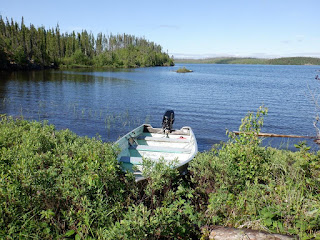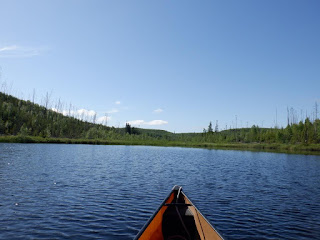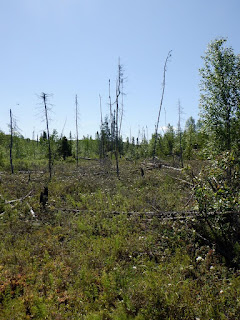July 3 at 8:25 p.m., on the way up the lake with canoe on top of motorboat to start work cutting the first portage. After heavy rain all last night, the day opens with mostly clear blue sunny skies.
9:15 a.m., the motorboat parked at the first very short eight metre portage to the small unnamed lake 9.6. It is securely tied to a large log on shore.
Canoe dragged across the portage, over a deep bed of sweet gale brush, and loaded with today's gear, ready to launch in unnamed lake 9.6. When I return to the cabin, the canoe with painters attached and two paddles underneath, will be parked upside down on this brush.
There is a narrow old beaver channel to paddle out into unnamed lake 9.6, which drains over an old beaver dam into the big lake. I camped on this small lake in 2018, but ran out of time to cut portages I now plan to do.
Paddling up the one km long unnamed lake 9.6 to the small unnavigable creek that drains the next unnamed lake 10 which is the same size.
Parking the canoe for the day at the best spot to allow me to cut a portage to unnamed lake 10.
Thinking I might be able to avoid the wet boggy muskeg along the creek, I walk on higher ground all the way to unnamed lake 10 but it is a real effort to make my way over all the down timber from the 2010 forest fire. It would take several days to cut a portage through this stuff.
The best spot to cut a portage proves to be closer to the creek through the muskeg. Though it is deep with moss and Labrador tea, the muskeg is more open and has much fewer down trees. Hopefully I can cut a trail today in one day.

Some of the locations through which I must cut a trail.

A log that is too big to step over when carrying heavy loads. Thinking that I cannot shift the log, I start to saw it. Being very hard to cut, I finally try picking the log up to move it and succeed, making me laugh out loud at myself.
After reaching the upper end of the portage at unnamed lake 10, photos above are of the cleared trail on my return to the canoe. Note the "bridge" of poles and brush used to make a path on a steep wet slope.
I stop for lunch at 11:30 a.m. to build a small smoky fire on the rock face above the canoe to shoo blackflies which have been very bothersome. Once the bugs are gone, I hang up my sweat-soaked upper clothes to dry a bit in the sun (short shirt, long shirt, hat) plus items rinsed in the lake (handkerchief, bandana, headnet). Soon I put on a dry shirt because of bothersome flies.
**********************
Summary:
Use motorboat to transport canoe to work to clear a portage. Beautiful sunny day ... yay! Wear headnet all day because of very bothersome blackflies. Cut a virgin 250 metre trail to the next lake. A challenge to back the motorboat away from its parking spot in the wind-blown waves. Fetch firewood poles with boat to take to cabin. Distance travelled by motorboat 22 km (11 km and return), portage canoe eight metres, paddle one km on small unnamed lake 9.6, cut portage 250 metres to next small unnamed lake 10.
July 3:
It is 15°C when I arise at camp 12's log cabin after raining heavy all last night. Later it is a beautiful sunny day with only a few clouds, calm at first light but soon a welcome wind for work, progressing from light to moderate to strong by the end of the day. From my journal: "Up by 3:45 a.m.. Slept fairly well. Flat where I laid but cabin floor slopes a bit too much till I find the right position in tent, all plywood which is good. Clothes hung last night didn't dry at all; short shirt still sweat-soaked ... clammy when I put it on! Open door for light, then window shutter. Dress standing on newspaper, of which any cabin should be well stocked. Great for a clean work surface; have newspaper on table to protect the top. A few mosquitoes enter, but as the sun rises higher, they disappear. Try the wood stove, a cooking range, but smoke exits everywhere except the chimney. Something wrong with the stovepipe draft, which I try in various positions with no success. Too bad stove doesn't work; will be okay if weather improves. Get firepit going to bake fresh cinnamon bannock for breakfast. There isn't much firewood around the cabin site, so will collect some dry poles with the boat later. Bail about 20 litres of water from the motorboat, mostly from last night's heavy rainfall, sponging out the last bit. There is a bailer and sponge in the boat. Before eating, I hang bedding on outside clothesline to take advantage of the sunshine and nice breeze. Hang tent fly over four kitchen chairs in the sun. They are all dry before I leave at 7:30 a.m.. Not sure how long it takes to reach the target spot; will time tomorrow after I am more familiar with the route, the boat, the landing and no canoe on top. Park the boat and securely tie it to a big log on shore, thankful that Brian gave me a long rope rather than the short ones used to tether to docks. Then unload the canoe and my gear onto the tall dense sweet gale brush that separates the big lake from small unnamed lake 9.6. [In areas where I have to canoe through or near unnamed water bodies, I typically assign numbers on my topographical map. I travelled in this area twice before; 9.6 is used because I had accidentally duplicated number 9 for two lakes between canoe seasons.] The brush and grass are soaked from yesterday's rain, but underfoot is also soggy back about two metres from the high water level of the small lake; I can hear the water trickling over the old beaver dam. The portage is only eight metres so I just drag the canoe from the big lake to the small, then load the gear which is my bailer, two paddles, two packs (containing items listed in yesterday's journal). Paddle one km up lake 9.6 to the incoming creek, going past my 2018 campsite without stopping. The creek is not navigable very far. Away from the creek, I pull into one spot but then look for a better landing on the wet muskeg which is surfaced with deep moss and Labrador tea, and sweet gale brush at the shore. Finding a somewhat drier location, I back the stern into a small indentation beside a tiny spruce tree. Upon tying the canoe, I send a SPOT™ message at 9:40 a.m. to indicate where I will be today; at 4:45 a.m. I also activated the SPOT™ at the cabin (which that early, typically means I will be at the location all day). When I get back to camp I send a third message so my contacts know I am back where I spent last night. Of course they may wonder what the heck I am doing. I will continue to send at least three SPOTs™ each day that I travel to cut portages. Unpacking the Tool Kit, I trim branches from one side of the spruce, using them to fill in a particularly deep wet place, fetching some dead wood to finish the job corduroy fashion. Hoping for a mostly dry trail across the terrain razed in the 2010 fire, I first explore the higher ground, up a steep rock face beneath the hundreds of down trees crisscrossed willy-nilly. Soon realizing it would take several days to cut a trail through these barriers, I target the muskeg closer to the creek, leveller low ground. Walking all the way to the next unnamed lake 10, I can surprisingly miss most really wet spots except for the occasional hole which I should be able to fill in or bypass. Portaging on muskeg is not my preference, walking is difficult, sinking into the deep springy moss with Labrador tea brush tripping me up, but one day of work making a trail versus several is preferable. There are lots of trees to cut, mostly down, but some still standing, also some birch and alder bushes. Closer to lake 10 I have to veer to higher ground because the low area is much too wet. Back to the canoe, I fetch my tools (bow saw, axe, pruner, leather mitts) and start work. Sweating just walking, I have already donned my headnet because the blackflies are very bothersome, soon to get bad; to seal the base of the net, I tie a bandana around my neck. As typical when cutting the down trees, it's like figuring a puzzle, which to cut first, like the pick-up-sticks game. There is a large 8" diameter log which will be hard to step over with a heavy load without tripping in the moss and brush. Thinking I cannot move it, I start sawing which proves to be difficult, the blade binding. I laugh out loud at myself when I finally try lifting and shoving the log aside and succeed. At 11:30 a.m. I am thirsty, hungry and feeling weak, possibly from dehydration as well as hunger, having not stopped to drink all morning. [It is a bother to drink with headnet on, so I delay until lunch, not a good idea.] Walking back to the canoe, which has been moored in the lake, I fetch my Rubber Pack and bailer filled with lake water. Then up to higher more windswept rock face ground to make a smoky fire to chase the bothersome blackflies. Standing in the smoke, finally I can remove the bandana, headnet, hat, long and short shirts. The latter is so sweat-soaked that I can wring water from it. Hang all the clothes to dry, spread over dead branches of down trees, headnet, bandana and handkerchief (used to mop my sweaty face) first rinsed in the lake. Am bare chested for a few minutes, but flies start to bother me so put on a dry long-sleeved T-shirt from my pack. I note that there are no standing trees to support a tarp shelter if it rains. After lunch I place my still wet short shirt to dry on the packs in the canoe, wearing the new shirt for the rest of the day under the heavier long shirt. The lake water is brown but clear, from decaying vegetation in this shallow water body; I use the LifeStraw® filter to drink water poured from the bailer at lunch. Man, it feels good to sit down, headnet off, dry shirt on, food in my belly, bootlaces loosened. Then repack Rubber Pack and return it to canoe. Back to work to finish the other half of cutting the portage. One place is on a steep sideling slope with deep water at the bottom, so have to place felled trees lengthwise on the trail to bridge the area. All done by 3 p.m. after five hours of steady work ... yay! Thanks to the gods for a beautiful day. Stepping out the newly cut trail, the portage is 250 metres long, a good day's work. Then a repeat of lunch procedures to dry off, except to eat I only have LifeStraw® water, plus some peanut butter as I am feeling weak again.
Dress again and paddle back to the motorboat. Load gear from canoe into boat. Drink all of the water from the one litre canteen. Turn canoe over on top of the brush at the eight metre portage, paddles underneath. The strong onshore wind makes it difficult to launch the boat. Use the boat paddle but it is too short to push out very far and the wind keeps pushing me back towards shore. Will cut a long birch pole at the cabin for tomorrow. Worried about the propeller hitting rocks, but manage to back out far enough to get away, with water coming over the stern into the boat. Don't have enough experience to know if doing a good enough job with the motorboat. Aie! My teacher Brian would maybe be shaking his head. When I motored in the morning, even though I have canoed here in 2018, and I have the topographical map and compass, I noted that it is harder to read the map because the landmarks go by much faster; it is best to slow down or stop to keep track. I mistakenly turned too soon at one point, so that now there were isles that weren't "supposed to be" so I stopped, looked at map and compass to sort myself out. Similar thing happens on the return trip I think, so stop but decide, no, I just turned too soon at a big island, going down the opposite side to where I came up in the morning. This explains why I have missed the spot I had mentally flagged to stop on the return for firewood poles. When I get in sight of the cabin, I land to find five good firewood poles, sawing them the length of the boat to fit nicely. Back at camp, I throw the poles onto shore where they will sit until tomorrow. Bail and sponge out the water from the boat that shipped in at the eight metre portage launch when I had to reverse into the waves. Hang all my still sweat-damp upper clothes on the outside clothesline, putting on my now dry short shirt. Start the firepit for supper which includes freshly picked fireweed greens. Prepare my meal, but set beside the fire to keep warm. Hang all remaining clothes and have a much needed bath, feels so good. Until supper dishes washed, dress in 'sweats' and loosened boots (no insoles, which are hanging to dry); then moccasins, sitting in cabin to eat and to write the day's journal. Drink lots of LifeStraw® water before supper, and the whole medium pot of water during supper; evidence I did get somewhat dehydrated today. Kill several horseflies and two types of smaller flies with the fly swatter in the cabin; they stop entering the open door as the sun lowers more. In bed by 9:30 p.m., a late night, so I shut Wilson off. Wish I didn't have to close window shutter ... oh well, c'est la vie. Sleep well, weary and tired."



























